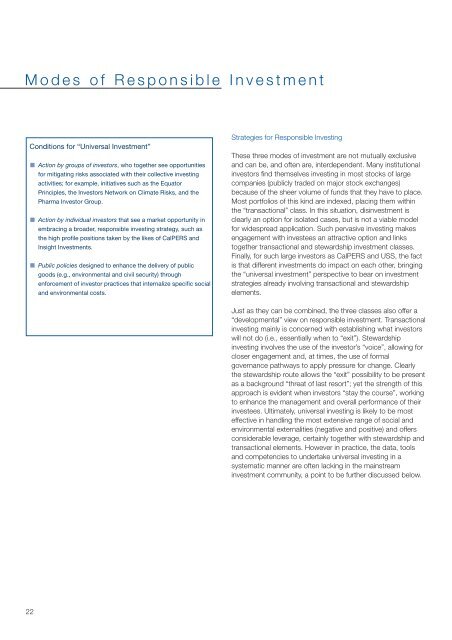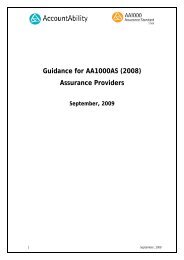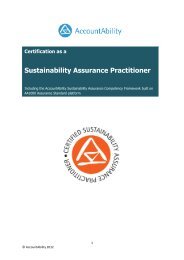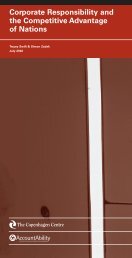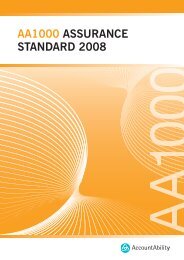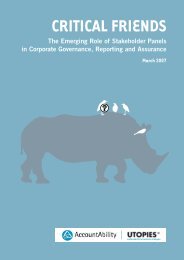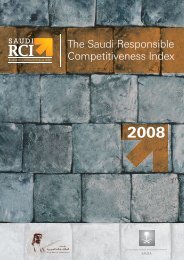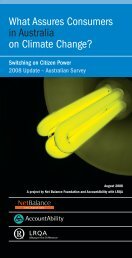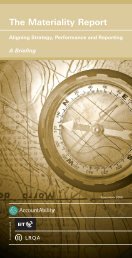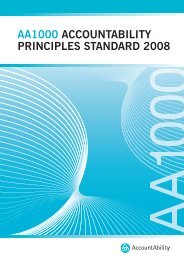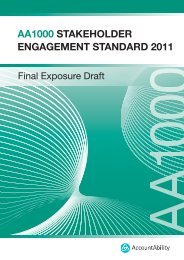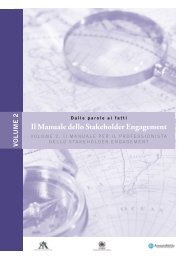Mainstreaming Responsible Investment - AccountAbility
Mainstreaming Responsible Investment - AccountAbility
Mainstreaming Responsible Investment - AccountAbility
You also want an ePaper? Increase the reach of your titles
YUMPU automatically turns print PDFs into web optimized ePapers that Google loves.
Modes of <strong>Responsible</strong> <strong>Investment</strong><br />
Conditions for “Universal <strong>Investment</strong>”<br />
Action by groups of investors, who together see opportunities<br />
for mitigating risks associated with their collective investing<br />
activities; for example, initiatives such as the Equator<br />
Principles, the Investors Network on Climate Risks, and the<br />
Pharma Investor Group.<br />
Action by individual investors that see a market opportunity in<br />
embracing a broader, responsible investing strategy, such as<br />
the high profile positions taken by the likes of CalPERS and<br />
Insight <strong>Investment</strong>s.<br />
Public policies designed to enhance the delivery of public<br />
goods (e.g., environmental and civil security) through<br />
enforcement of investor practices that internalize specific social<br />
and environmental costs.<br />
Strategies for <strong>Responsible</strong> Investing<br />
These three modes of investment are not mutually exclusive<br />
and can be, and often are, interdependent. Many institutional<br />
investors find themselves investing in most stocks of large<br />
companies (publicly traded on major stock exchanges)<br />
because of the sheer volume of funds that they have to place.<br />
Most portfolios of this kind are indexed, placing them within<br />
the “transactional” class. In this situation, disinvestment is<br />
clearly an option for isolated cases, but is not a viable model<br />
for widespread application. Such pervasive investing makes<br />
engagement with investees an attractive option and links<br />
together transactional and stewardship investment classes.<br />
Finally, for such large investors as CalPERS and USS, the fact<br />
is that different investments do impact on each other, bringing<br />
the “universal investment” perspective to bear on investment<br />
strategies already involving transactional and stewardship<br />
elements.<br />
Just as they can be combined, the three classes also offer a<br />
“developmental” view on responsible investment. Transactional<br />
investing mainly is concerned with establishing what investors<br />
will not do (i.e., essentially when to “exit”). Stewardship<br />
investing involves the use of the investor’s “voice”, allowing for<br />
closer engagement and, at times, the use of formal<br />
governance pathways to apply pressure for change. Clearly<br />
the stewardship route allows the “exit” possibility to be present<br />
as a background “threat of last resort”; yet the strength of this<br />
approach is evident when investors “stay the course”, working<br />
to enhance the management and overall performance of their<br />
investees. Ultimately, universal investing is likely to be most<br />
effective in handling the most extensive range of social and<br />
environmental externalities (negative and positive) and offers<br />
considerable leverage, certainly together with stewardship and<br />
transactional elements. However in practice, the data, tools<br />
and competencies to undertake universal investing in a<br />
systematic manner are often lacking in the mainstream<br />
investment community, a point to be further discussed below.<br />
22


